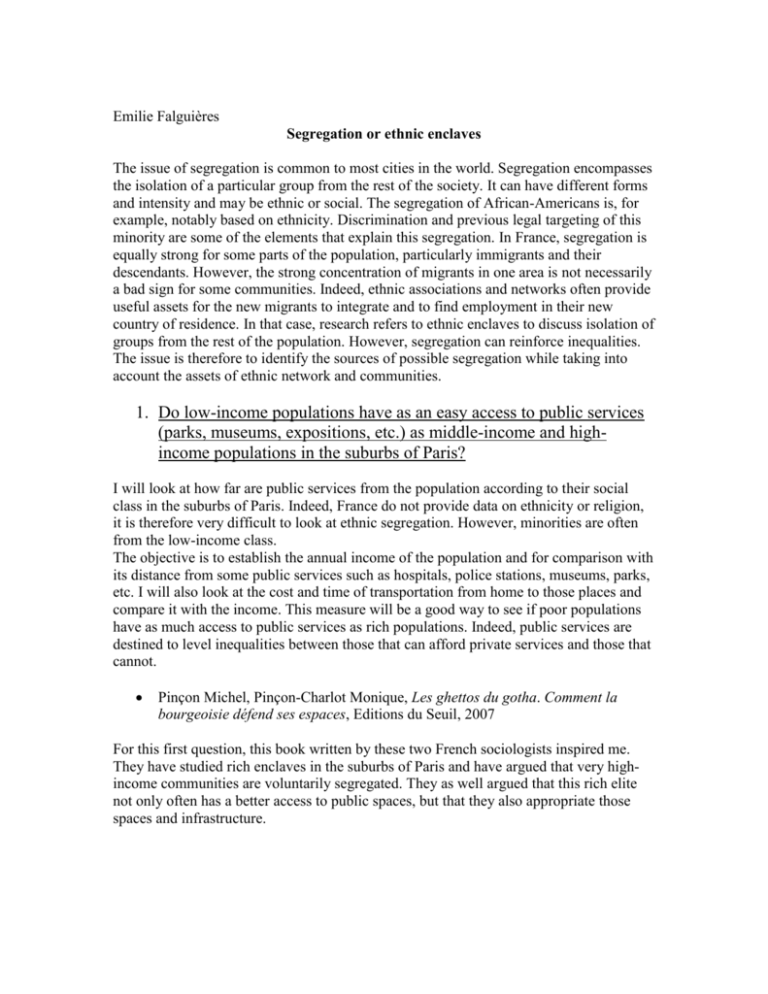GIS Assignment 2
advertisement

Emilie Falguières Segregation or ethnic enclaves The issue of segregation is common to most cities in the world. Segregation encompasses the isolation of a particular group from the rest of the society. It can have different forms and intensity and may be ethnic or social. The segregation of African-Americans is, for example, notably based on ethnicity. Discrimination and previous legal targeting of this minority are some of the elements that explain this segregation. In France, segregation is equally strong for some parts of the population, particularly immigrants and their descendants. However, the strong concentration of migrants in one area is not necessarily a bad sign for some communities. Indeed, ethnic associations and networks often provide useful assets for the new migrants to integrate and to find employment in their new country of residence. In that case, research refers to ethnic enclaves to discuss isolation of groups from the rest of the population. However, segregation can reinforce inequalities. The issue is therefore to identify the sources of possible segregation while taking into account the assets of ethnic network and communities. 1. Do low-income populations have as an easy access to public services (parks, museums, expositions, etc.) as middle-income and highincome populations in the suburbs of Paris? I will look at how far are public services from the population according to their social class in the suburbs of Paris. Indeed, France do not provide data on ethnicity or religion, it is therefore very difficult to look at ethnic segregation. However, minorities are often from the low-income class. The objective is to establish the annual income of the population and for comparison with its distance from some public services such as hospitals, police stations, museums, parks, etc. I will also look at the cost and time of transportation from home to those places and compare it with the income. This measure will be a good way to see if poor populations have as much access to public services as rich populations. Indeed, public services are destined to level inequalities between those that can afford private services and those that cannot. Pinçon Michel, Pinçon-Charlot Monique, Les ghettos du gotha. Comment la bourgeoisie défend ses espaces, Editions du Seuil, 2007 For this first question, this book written by these two French sociologists inspired me. They have studied rich enclaves in the suburbs of Paris and have argued that very highincome communities are voluntarily segregated. They as well argued that this rich elite not only often has a better access to public spaces, but that they also appropriate those spaces and infrastructure. Mobilité, accessibilité et équité : pour un renouvellement de l’analyse des inégalités sociales d’accès à la ville Sylvie Fol (Université Paris 1 Panthéon – Sorbonne, UMR Géographie - Cités) Caroline Gallez (LVMT-IFSTTAR) This paper looks at the issues of accessibility and mobility for low-income populations. It reminds that the main indicators used in the literature to measure accessibility are location-based measures, individual’s accessibility indicators, and utility-based measures. Cumber, Alexis, Brunsdon Chris, Green, Edmund, Using a GIS-based network analysis to determine urban greenspace accessibility for different ethnic and religious groups, Landscape and Urban planning, 2008 https://lra.le.ac.uk/jspui/bitstream/2381/4649/1/8a.%20comber_et_al_greenspaces_lup_re submission_mod.pdf Using GIS, this paper examines how ethnic minorities in different cities have access to green areas. Data: Data regarding income is available from the INSEE (National institute of statistics and economic studies) via their website: http://www.insee.fr/en/default.asp 2. What is the distance from home to work for low-, middle- and highincome populations in the suburbs of Paris? What type of transportation is used? The time taken to travel to the job place is often a burden in big cities such as Paris. This question can show inequalities in term of access to work and provide useful incentive and indication for policy regarding public transportation. Work Together, Live Apart? Geographies of Racial and Ethnic Segregation at Home and at Work Author(s): Mark Ellis, Richard Wright, Virginia Parks Reviewed work(s): Source: Annals of the Association of American Geographers, Vol. 94, No. 3 (Sep., 2004), pp. 620-637 http://www.elegantbrain.com/edu4/classes/readings/depository/race/resid_segreg_latin_el lis_wrig_park.pdf This paper is interesting for its look at how much segregation exists in the workplace in comparison to the neighborhoods of those same Mexicans and natives. Data: I could not find data on households’ job places. 3. Using the index of dissimilarity, how much segregated are communities in Mumbai, India and what is the impact on ethnic conflict ? The index of dissimilarity is one of the main indexes of segregation. This spatial analysis may show potential correlation between high level of ethnic conflict such as riots and segregation. Gayer Laurent, Jaffrelot, Christophe, Muslims in Indian Cities: trajectories of marginalization, Columbia University Press, 2012 Data: No data found on dissimilarity index regarding ethnic groups. 4. Over the last 20-30 years, what has been the density of ethnic associations (services or religious centers) in the city of Marseille? This question will allow an analysis of how ethnic communities organize themselves and how much ethnic communities strengthen their community, or on the contrary assimilate and loosen ethnic ties. Deborah Phillips, Ethnic and Racial Segregation: A Critical Perspective, Geography Compass, Volume 1, Issue 5, September 2007 http://onlinelibrary.wiley.com/doi/10.1111/j.17498198.2007.00051.x/abstract?deniedAccessCustomisedMessage=&userIsAuthenticated=fa lse This paper focuses on the different definitions of ethnic segregation and at how much ethnic clustering can facilitate integration. Data: No data on ethnicity is officially available in France and I have not found data on ethnic networks or associations.








